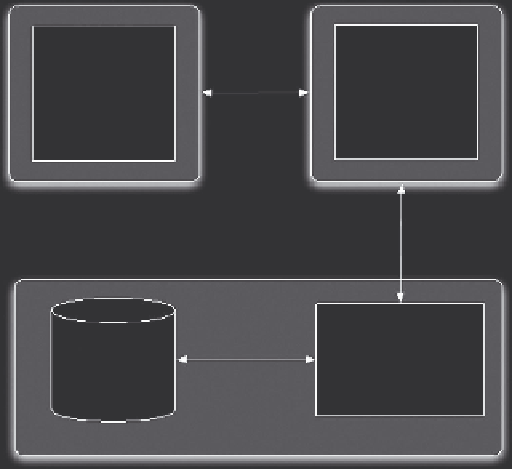Geoscience Reference
In-Depth Information
NeISS portal server
Gateway machine
Simulation web
services
Portal web site
Internal model
data
Simulation
software
Arc1 Grid resources
FIGURE 10.5
The NeISS hardware infrastructure.
are decentralised and essentially hidden from the view of the end user. This approach stems from
the
grand vision
of grid computing, which is one where people receive computing resources in the
same way that they receive other services such as electricity, gas and water - they have no interest
in where (and how) the computations are performed.
This vision is already being realised in some sectors under the term
cloud
computing. For exam-
ple, users of Google Docs, which is a service that allows people to create and save documents using
a web browser, have no knowledge of where their documents are actually stored. Similarly, those
using Fusion Tables (another Google service) do not need to know where in the world the comput-
ers that perform any expensive database queries are actually located. Users simply access a website
using their browser as they would any other.
For e-Research, however, progress has been less forthcoming. Individual applications such as
NeISS are able to make use of grid resources, but these still submit processing jobs to predetermined
hardware. As an example of this process, part of the NeISS hardware infrastructure is illustrated
in Figure 10.5. Users access a portal website (which in this instance is located at a different site to
that which executes the models) and use this to log into and configure their simulation(s). Access
to simulations is provided through web services that, in turn, communicate with the grid hardware.
Local capacity at Leeds (the Arc1 Grid resource) is used to actually run the models. Although the
user is able to monitor the status of their simulations and receive results through the portal (via
associated web services) without being aware of where their simulations are being executed, models
will
always
run on the Leeds grid machine.
However, new
cloud
services are emerging that could render these institutional grids redun-
dant for e-Research. Amazon Web Services (http://aws.amazon.com/) and Google Computer
Engine (http://cloud.google.com/products/compute-engine.html), amongst others, offer the ability
to instantly obtain individual virtual machines or computer processors as they are required. An
e-Research application could request the resources it needs, perform calculations and then release
them dynamically. Data can be managed in the same way: additional data storage can be resourced
as required and then released afterwards. In this sense, cloud computing offers a valuable means

